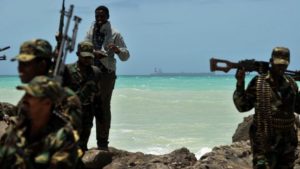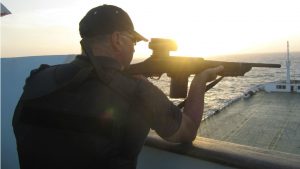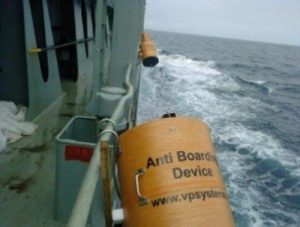 Marine piracy has a long history. But only in recent years has it transformed into a well-organized criminal business posing a problem for the shipping industry and a serious threat for seafarers. Modern pirates are not interested in primitive “smash and grab” attacks. They hijack vessels to kidnap crew and steal valuable cargo. These guys are usually well-informed about their potential victim ship and adequately armed for the job. So, what are the legal means of protection against such a force?
Marine piracy has a long history. But only in recent years has it transformed into a well-organized criminal business posing a problem for the shipping industry and a serious threat for seafarers. Modern pirates are not interested in primitive “smash and grab” attacks. They hijack vessels to kidnap crew and steal valuable cargo. These guys are usually well-informed about their potential victim ship and adequately armed for the job. So, what are the legal means of protection against such a force?
Knowing your Enemy
Almost all mariners can name pirates’ hotspots even if waken in the middle of the night. The Gulf of Aden/Horn of Africa, Nigeria and the Gulf of Guinea, Southeast Asia and especially Strait of Singapore, Venezuela coast, etc. – all these areas are infested with pirates who despite having similar goals (kidnap the crew, demand a ransom) tend to operate different weapons and demonstrate distinctive behavior depending on the region.
The International Maritime Bureau Piracy Report shows that except those hunting off the Bangladesh coast (armed by knives only) Asian pirates are by far equipped the best. Even local fishing boat was attacked with the help of M16 riffles near Malaysia in September 2018. On the African East coast pirates also use automatic or semi-automatic weapons, sometimes even RPGs; but those are applied for the dramatic effect only. West coast of Africa is littered with guns; and here pirates might be as much interested in cargo and valuables stored on the vessel as in crew kidnapping. Piracy was spurred in South America by the recent economical crisis and political insurgency. As a result, marine pirates are not as ‘civilized’ there as, for instance, in the Gulf of Aden and are prone to crude robbery.
Constant Vigilance
Regardless of the nationality, pirates usually choose the same tactic. They mostly pick bulk carriers and tankers as their victims and approach them on speedy skiffs firing at the bridge. Most attacks happen at dawn and dusk when the lights are low.
 Reports also show that in all those cases when crews managed to deter the assaults successfully they had noticed pirates approach in advance and fired the alarm. Therefore, vigilant watches both on the deck and via radar and CCTV will increase chances of deterring pirates significantly.
Reports also show that in all those cases when crews managed to deter the assaults successfully they had noticed pirates approach in advance and fired the alarm. Therefore, vigilant watches both on the deck and via radar and CCTV will increase chances of deterring pirates significantly.
Ideally, there might be an armed security onboard taking full care of the incident. As a rule, once they ‘convey’ by several shots that the vessel is going to offer resistance, the gang retreats to look for more vulnerable target. But armed security is expensive and still rather dubious acquisition.
Pirates Deterrents
Well, the crew have noticed an approaching danger, but pirates are usually armed and peopled onboard aren’t. There are several means of protection, though:
- Firstly, never stop the vessel. Keep maneuvering at top speed to ensure aggressive wake which might upturn a small pirate’s skiff.
- The easiest defense measures available are barbed wire fences, fire hoses and water cannons that are targeted at pirates to prevent them from climbing on board. The latter are often operated remotely and can also be used to fill pirates’ boats in and drown them.
Another simple recipe is Molotov cocktail. Empty bottles filled with gasoline and stuffed with burning cloths were successfully used against pirates by Chinese crew in the GOA.  More intricate non- lethal weapons include, for instance, Anti-Piracy Curtain. This unique method was developed by Japanese engineers and who suggested hoses dangling from both sides of the vessel with water passed through the nozzles at the force of 0.2 MPa causing the hoses to whirl around hurting anyone trying to get on board.
More intricate non- lethal weapons include, for instance, Anti-Piracy Curtain. This unique method was developed by Japanese engineers and who suggested hoses dangling from both sides of the vessel with water passed through the nozzles at the force of 0.2 MPa causing the hoses to whirl around hurting anyone trying to get on board.
Another interesting technology was presented by American International Maritime Security Network. They have developed Liquid Deterrent System – foul smelling and stinging green liquid which should be showered on the approaching pirates. As a result, the attack will die out as the substance causes people to jump into the water to get rid of the smell and irresistible skin burning sensation.
 Also highly effective are Secure Electric Fences and Razor Wire Canisters which are more sophisticates versions of barbed wire barricades; and various types of net boat traps called to ensnare propellers of pirates’ boats and subsequently disable the skiffs.
Also highly effective are Secure Electric Fences and Razor Wire Canisters which are more sophisticates versions of barbed wire barricades; and various types of net boat traps called to ensnare propellers of pirates’ boats and subsequently disable the skiffs.
Non-lethal Weapons
Other non-lethal weapons include long range acoustic (LRAD) and laser devices, Active Denial System, compressed air launcher, rubber ball grenades, dazzle guns and electric shockers which even sound unconvincing when you know that the other side has Kalashnikovs. Therefore, if above mentioned means proved ineffective in preventing pirates from climbing onboard, no further resistance must be offered.
What to Do if Pirates Are on Board (instructions provided by Maritime Security Centre – Horn of Africa)
- Once the crew noticed approaching pirates the nearest coastal security service should be informed immediately.
- If possible notify the Navy; transmit Mayday signals to all merchant vessels in vicinity and send satellite messages; make your ship as conspicuous for rescuers as possible.
- Fortify the bridge and engine room. Use barbed wire, chains or any available resources to impede pirates’ access to these crucial points. It would also be a good idea to protect bridge personnel with body armor and helmets as it is vital to keep vessel moving whilst pirates usually fire at the bridge to make officers slow down.
- If the vessel is equipped with a safe area (some ships are furnished with Citadel, a fortified room with a stock of food and water where crew can retreat in case of an attack), gather as many crew members as possible there.
- Never be aggressive in your interaction with pirates; don’t make sharp movements and don’t use firearms even if you are in possession of any.
- In case military service are able to intervene, experts of advise crew to lie down on deck with both hands empty and protecting the head; wait for further instructions from them.
According to the popular resource Statista.com, which processes information from 22,500 data channels, recent years have shown quite an optimistic downturn in the number of pirate attacks against ships all around the world. Where there have been as many as 445 hijackings in 2010; various sources spotted only 180 pirate related incidents in 2017. However, the threat is still imminent; and maritime community has a long way to go before the problem of piracy can be eradicated for good.

